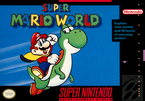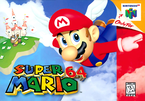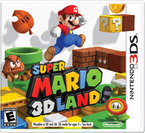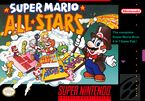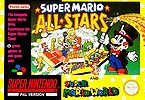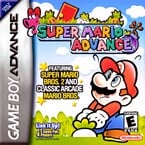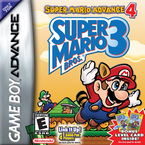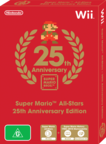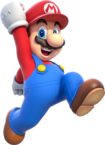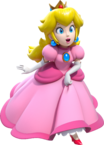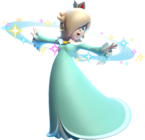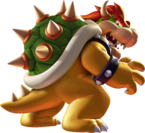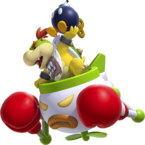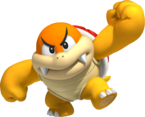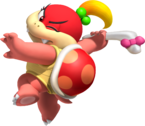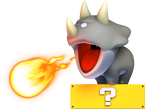Super Mario (series)
Template:Articleabout Template:Series-infobox The Super Mario series, also called the main series or main games, is the biggest and most important sub-series of the Mario series. It started in 1985 with the creation of Super Mario Bros. on the Famicom and subsequently the Nintendo Entertainment System. It has been followed by many sequels released in almost every Nintendo video game console to date, except the Game Boy, the Game Boy Color, and the Game Boy Advance, where only remakes, ports, or other spin-offs games where released.
Most of these games, notably excluding Super Mario Bros. 2, Super Mario World 2: Yoshi's Island,[1] and the Super Mario Land series, follow the story of Mario and, usually, his brother Luigi and sometimes his best friend Yoshi, in their quest to search for and rescue Princess Peach from the clutches of Bowser, who wants to conquer the Mushroom Kingdom, or another location, depending on the game. The Mario brothers' adventure is not easy, however, as they must face Bowser's troops throughout, who attempt to thwart the brothers' attempts to rescue the princess.
All the games, and even some remakes, have been developed exclusively by the Nintendo Entertainment Analysis and Development (also known as Nintendo EAD) branch but not by the same sub-division.
In 2010, the series celebrated the twenty-fifth anniversary of the release of Super Mario Bros.. The celebration involved a series of videos showing various tricks throughout the series' games on the Wii's Nintendo Channel, as well as releasing a Wii port of Super Mario All-Stars, which included a history booklet of the Super Mario series and a CD containing several songs from games in the series.
Main games
It has been requested that this article be rewritten and expanded to include more information.
| Title, original release and system | Synopsis and Ratings |
|---|---|
| Super Mario Bros.
|
Super Mario Bros. is the first installment in the Super Mario series. It was first released for the Famicom and the NES in 1985. This game set the standard for the later games, and it was eventually re-released for many newer systems, including the Game Boy Advance and the Virtual Console for the Wii. This game marks the first appearance for many new protagonists, species, and villains. These characters include Bowser, Princess Peach (then known as Princess Toadstool), Toad and the Mushroom Retainers, Goombas, Koopa Troopas, and many more. |
| Template:Releasedate NES | (Ratings unavailable) |
| Super Mario Bros.: The Lost Levels
|
A year after the release of Super Mario Bros., Nintendo released Super Mario Bros.: The Lost Levels. It was released for the Famicom Disk System. It uses a slightly altered version of Super Mario Bros.'s engine, with different levels and new features including altered graphics and new enemy behavior. This game is known in Japan as Super Mario Bros. 2; Nintendo of America originally deemed this game too challenging and too much like the original to sell well in western countries. However, the game made its appearance in western countries as part of Super Mario All-Stars, and recently, this game was released for the Virtual Console on the Wii. |
| Template:Releasedate Famicom | (Ratings unavailable) |
| Super Mario Bros. 2
|
Super Mario Bros. 2 is the third game in the Super Mario series. It was released in 1988 for the Famicom and the NES. New species first appear in this game, including Albatoss and Shy Guys, and it introduces Wart and Birdo. Super Mario Bros. 2 is also the first game to feature four distinctly playable characters (Mario, Luigi, Toad, and Princess Peach). Super Mario Bros. 2 was based on the Japanese game Yume Kōjō: Doki Doki Panic. In Japan, this game is commonly called Super Mario USA. |
| Template:Releasedate NES | (Ratings unavailable) |
| Super Mario Bros. 3
|
Super Mario Bros. 3 is the fourth Super Mario game. It was released for the Famicom and the NES. Many new species appear, including now-staples like Boo and Spike. Boom Boom, Dry Bones, and the Koopalings also first appear here. New power-ups also appear such as the Super Leaf, the Hammer Suit and the Frog Suit. It has been considered as one of the greatest games of all time. Its complexity and challenging levels made it a huge success. In addition to new power ups, it featured new moves, items, and enemies. It also features special non-level parts of each world, including Toad Houses where lives are earned and Spade Panels, as well as some secret parts, such as the White Toad House and the Treasure Ship. |
| Template:Releasedate NES | (Ratings unavailable) |
| Super Mario World
|
Super Mario World was released in 1990 for the Super Famicom. It was also re-released as the second installment in the Super Mario Advance series. In this game Mario and Peach go on a trip to Dinosaur Land but things go awry when Bowser kidnaps Peach. This game was notable for introducing Yoshi and the species. It is the fifth installment in the Super Mario series. |
| Template:Releasedate SNES | (Ratings unavailable) |
| Super Mario 64
|
Super Mario 64 has its own unique gameplay and story to the Super Mario series. It was released in 1996 for the Nintendo 64. In this game, Mario uses Power Stars to retrieve the kidnapped Peach. Mario jumps into paintings trying to find Peach. Unlike prior games, the goal of the levels in Super Mario 64 is not to find the end of the stage; rather, Mario must find Power Stars by completing missions in each course. This is also the first 3D game in this series. Though it was not the first 3-D platforming game, it revolutionized the genre, with many games soon following its formula, using it as a sort of benchmark. It is widely acclaimed as one of the greatest games of all time. A remake for this game came out in 2004 for the Nintendo DS called Super Mario 64 DS. This game introduced new bosses, such as King Bob-omb and Eyerok. |
| Template:Releasedate Nintendo 64 | IGN - 9.8: Amazing• Gamespot - 9.4: Superb |
| Super Mario Sunshine
|
Super Mario Sunshine was released in 2002 for the Nintendo GameCube. Its gameplay is similar to Super Mario 64; however, it has a unique storyline. Mario, Princess Peach, and Toadsworth are taking a vacation to Isle Delfino, when they find that the island has been vandalized and the Shine Sprites stolen by a strange enemy that looks like Mario himself. Mario is then taken into custody and tasked with cleaning up the entire island. Instead of collecting Power Stars, the player collects Shine Sprites. This game also introduced many recurring characters and bosses in the Mario series, including Toadsworth, Bowser Jr., Petey Piranha, Gooper Blooper, Piantas, Nokis, Shadow Mario, and FLUDD. Super Mario Galaxy is the respective follow-up to this game. This is the second 3D game in the series. |
| Template:Releasedate Nintendo GameCube | IGN - 9.4: Outstanding • Gamespot - 8.0: Great |
| New Super Mario Bros.
|
New Super Mario Bros. is the eighth installment in the Super Mario series. It starts out when Bowser Jr. kidnaps Peach during a strange accident. Luigi is playable in this game, too. Luigi was not playable since Super Mario World. This is the first game since Super Mario World (1990) that features the classic 2D play-style of the Super Mario Bros. games. The game features a solo story mode with Mario or Luigi, a two-player wireless game Mario vs. Luigi, as well as a mini-game mode for up to four players. It was released in 2006 for the Nintendo DS. It spiraled a sequel, New Super Mario Bros. Wii, though that game is not considered to be a direct sequel to the DS game. |
| Template:Releasedate Nintendo DS | IGN - 9.5: Incredible • Gamespot - 9.0: Superb |
| Super Mario Galaxy
|
Super Mario Galaxy is the ninth installment in the Super Mario series and the third 3D game in the series. However, unlike the previous two 3D installments for the Mario series, this game takes place in deep space. Mario attends the Star Festival at the request of Princess Peach, when the town comes under attack by Bowser's air forces. He abducts Peach's entire castle and warps it to the center of the universe, prompting Mario to save her. Most of the game's levels consist of many small planets and planetoids, while others have bigger planets. A new popular species and character appear, Luma and Rosalina. It was released in 2007 for the Wii. This game spiraled a direct sequel, simply called Super Mario Galaxy 2. It is the first 3D game that has done so. |
| Template:Releasedate Wii | IGN - 9.7: Outstanding • Gamespot - 9.5: Superb |
| New Super Mario Bros. Wii
|
New Super Mario Bros. Wii is the tenth installment in the Super Mario series and the second for the Wii. It is an indirect follow-up to New Super Mario Bros.. In this game, Yoshis are rideable and the Koopalings return. In addition to the single-player experience, the game also features a multiplayer mode for up to four players simultaneously. This is the first time simultaneous multiplayer is possible in a Super Mario game. Two new playable characters appear, Yellow Toad and Blue Toad. New power-ups also appear including the Propeller Suit and the Penguin Suit. |
| Template:Releasedate Wii | IGN - 8.9: Great • Gamespot - 8.5: Great |
| Super Mario Galaxy 2
|
Super Mario Galaxy 2 is the eleventh installment in the Super Mario series. It is also the fourth 3D game in the series. The sequel contains many elements from its predecessor, such as the story, the adventure being in outer space, recurring objects such as Launch Stars, recurring items including the Bee Mushroom, and the elements of gravity. However, the game introduces new elements such as the utilization of Yoshi and new power-ups such as the Cloud Flower. Rosalina reappears and new characters of the Luma species appear including Lubba. This is the third installment for the Wii in the Super Mario series. |
| Template:Releasedate Wii | IGN - 10.0: Masterful • Gamespot - 10.0: Prime |
| Super Mario 3D Land
|
Super Mario 3D Land is the fifth 3D game in the series, and the twelfth game overall. The levels of Super Mario 3D Land are much more linear and compact than the other 3D titles, more along the lines of the side-scrolling games. Many retro power-ups and characters return, such as Bowser Impostors, the Super Leaf and Boom Boom. New power-ups are also introduced, such as Boomerang Mario, and White Tanooki Mario. It also introduces new enemies and a female partner of Boom Boom named Pom Pom. |
| Template:Releasedate Nintendo 3DS | IGN - 9.5: Amazing • Gamespot - 8.0: Good |
| New Super Mario Bros. 2
|
New Super Mario Bros. 2 is another side-scroller in the series released in 2012 for the Nintendo 3DS. It's the third game in the New Super Mario Bros. line and a direct sequel to New Super Mario Bros.. The game features an extremely large amount of coins, which are one of the game's main elements. Raccoon Mario makes a return. A new power-up called the Gold Flower appears and turns Mario into Gold Mario. |
| Template:Releasedate Nintendo 3DS | IGN - 8.5: Great • Gamespot - 7.0: Good |
| New Super Mario Bros. U
|
New Super Mario Bros. U is a side-scroller for the Wii U. The game seems to borrow some elements from Super Mario World such as Baby Yoshis, Sumo Bros., Bony Beetles, etc. and minor references like diagonal pipes making a return. The game plays very similar to New Super Mario Bros. Wii with its four-player mode, however a player with a Wii U GamePad can create platforms in what Nintendo refers to as "Boost Mode". It is the first Super Mario game (and Mario game overall) to be released in high-definition. The game also introduces a new form, Flying Squirrel Mario. |
| Template:Releasedate Wii U | IGN - 9.1: Amazing • Gamespot - 8.5: Great |
| Super Mario 3D World
|
Super Mario 3D World is the console follow-up to Super Mario 3D Land. The game's main feature is the Cat Mario transformation, caused by picking up a Super Bell. It also features the entire playable cast of Super Mario Bros. 2 as playable characters, featuring the same abilities they have in said game. The story follows Mario, Luigi, Princess Peach, and Toad as they attempt to rescue the Sprixie Princesses that Bowser has captured and free the Sprixie Kingdom. |
| Template:Releasedate Wii U | IGN – 9.6 - Amazing • GameSpot – 9 - Superb |
Ports, remakes, and downloadable content
| Title, original release and system | Synopsis and Ratings |
|---|---|
| Super Mario Bros. (Game & Watch)
|
In 1987, a simplified take on the Super Mario Bros. formula was released for the Game & Watch. It is a sidescroller where Mario had to move over several platforms, avoiding Lakitus and Bullet Bills. |
| Template:Releasedate Game & Watch | (Ratings unavailable) |
| Super Mario All-Stars
|
Super Mario All-Stars also known as Super Mario Collection in Japan was released in 1993 also for the Super Nintendo Entertainment System. It is a remake of the first four Super Mario series games. Super Mario Bros., Super Mario Bros. 2 Super Mario Bros. 3, and Super Mario Bros.: The Lost Levels. This game updated the four games' graphics and sound to enhance them. However, it is not technically considered an installment because it is just a simple remake. |
| Template:Releasedate SNES | (Ratings unavailable) |
| Super Mario All-Stars + Super Mario World
|
Super Mario All-Stars + Super Mario World is an America/Europe-only remake of Super Mario All-Stars that also includes Super Mario World for the Super Nintendo Entertainment System. It is the second remake of the series. |
| Template:Releasedate SNES | (Ratings unavailable) |
| Super Mario Bros. Deluxe
|
Super Mario Bros. Deluxe is a Game Boy Color remake which includes the first two Super Mario games ever released: Super Mario Bros. and Super Mario Bros.: The Lost Levels (that last under the name of Super Mario Bros.: For Super Players). Besides those games, it also featured many other collectibles, including images that could be printed with the Game Boy Printer, Cable Link interface multi-player, records sharing by infrared connection, a calendar, a fortune teller, etc. Unlike other remakes, it wasn't developed by Nintendo EAD, but by Nintendo R&D2. |
| Template:Releasedate Game Boy Color | IGN - 10: Masterful • Gamespot - 9.9: Superb |
| Super Mario Advance
|
Super Mario Advance is a remake of Super Mario Bros. 2 made for the handheld game system, the Game Boy Advance, and released in 2001. Like the Super Mario All-Stars port, Super Mario Advance had updated graphics. |
| Template:Releasedate Game Boy Advance | IGN - 8.0: Great • Gamespot - 8.2: Great |
| Super Mario World: Super Mario Advance 2
|
Super Mario World: Super Mario Advance 2 is a remake of Super Mario World made for the Game Boy Advance. It was the second title in the Super Mario Advance series and was released in 2002. There are various differences between the original Super Mario World and Super Mario Advance 2. The game was a gigantic hit for Nintendo and the Game Boy Advance, selling 3,290,000 copies in the United States and 5,460,000 copies worldwide. Additionally, Luigi's sprite has been changed and made taller than Mario to match his normal appearance, and the Mario Bros. classic game has been included in the game (like the other Mario Advance games), with multiplayer playable. |
| Template:Releasedate Game Boy Advance | IGN - 9.3: Amazing • Gamespot - 9.4 |
| Super Mario Advance 4: Super Mario Bros. 3
|
In 2003, the fourth entry in the Super Mario Advance series, Super Mario Advance 4: Super Mario Bros. 3, was released for the Game Boy Advance. It boasted similar graphics and sound to the Super Mario All-Stars version, and made use of the e-Reader. A few e-cards came included with new copies of the game, while two sets (referred to as "series") of cards, were released and sold alongside the game. By scanning special cards into the e-Reader, players were able to upload items, videos, and most importantly, new levels into the game. One notable item was the Cape Feather from Super Mario World, which allowed Mario to transform into Cape Mario. There were also two Switch cards that the player could activate (and deactivate) the effects of by scanning them; the Orange Switch and the Blue Green Switch. Scanning these switches triggered small functions in the game. The e-Reader feature is still available in the European version, but it is disabled by default and unable to access. |
| Template:Releasedate Game Boy Advance | IGN - 9.5: Amazing • Gamespot - 8.9: Great |
| Classic NES Series: Super Mario Bros.
|
The original NES version of Super Mario Bros. was released for the Game Boy Advance as part of the Classic NES series of games in commemoration for the 20th anniversary of the release of the original Famicom and NES. It is a port, and doesn't feature any new additions, and all of the bugs were left in the game and only the graphics were down-scaled to fit the GBA screen resolution. |
| Template:Releasedate Game Boy Advance | (Ratings unavailable) |
| Famicom Mini: Super Mario Bros. 2
|
In Japan, the Classic NES Series were known as Famicom Mini. The original Super Mario Bros. 2 (known in western regions as Super Mario Bros.: The Lost Levels) was released only in Japan. Much like Super Mario Bros., it didn't feature any new additions, the bugs were left untouched, and the graphics were down-scaled. |
| Template:Releasedate Game Boy Advance | (Ratings unavailable) |
| Super Mario 64 DS
|
Super Mario 64 DS is a remake of Super Mario 64. It was released in 2004 for the Nintendo DS. It is also the first Mario game released for the Nintendo DS. Though it is a remake, there are many differences between it and the original. One difference is that there are many additional secret stars, making 150 Power Stars instead of the previous 120. Wario, Luigi, and Yoshi are also playable, and mini-games were added. |
| Template:Releasedate Nintendo DS | IGN - 8.9: Great • Gamespot - 8.4: Great |
| Super Mario All-Stars Limited Edition
|
Released for the Wii in 2010, Super Mario All-Stars Limited Edition celebrates the 25th anniversary of Mario featuring the same games as mentioned in the All-Stars section. It is a port of the original game Super Mario All-Stars. |
| Template:Releasedate Wii | IGN - 7.0: Good |
| New Super Luigi U
|
New Super Luigi U is a game released to celebrate the Year of Luigi. It retains many graphics and features, such as the story and world map, have been retained from New Super Mario Bros. U, as it has also been released as a DLC title for said game. However all of the levels have been changed, and this time, Mario is absent, making Luigi the main character. Nabbit has been made a playable character, taking Mario's place. The packaged version was available at retail until the end of the Year of Luigi (2013). |
| Template:Releasedate Wii U | IGN - 7.3: Good |
| New Super Mario Bros. U + New Super Luigi U File:Box NA - New Super Mario Bros. U + New Super Luigi U.png |
A compilation of both New Super Mario Bros. U and New Super Luigi U on the same disc, released exclusively with the Mario & Luigi Deluxe Wii U set (known as the Premium Pack in Europe). New Super Mario Bros. U + New Super Luigi U includes notable changes to the originals, including a new title screen and over 200 videos included as bonus content. |
| Template:Releasedate Wii U |
Characters
This section is under construction. Therefore, please excuse its informal appearance while it is being worked on. We hope to have it completed as soon as possible.
Main protagonists
| Character | Brief Biography | First Appearance |
|---|---|---|
| Mario
|
Mario is the main protagonist in his titular series of games. Throughout almost thirty years, Mario has been the star of the largest game franchise Nintendo has published. Many characters have fought alongside Mario in his adventures in platformers and RPGs, but many have also fought against him during those times. Mario has gone through many physical changes, from his original 8-bit appearance, to his current 128-bit appearance. Mario commonly rescues Princess Peach, as well as several others, such as Mushroom Retainers, as his adventures continue. Mario has even been accepting enough to team up at times with his greatest foe, Bowser. | |
| Luigi
|
Luigi is Mario's taller, younger, twin brother. Luigi first debuted alongside Mario in Mario Bros. in 1983, fighting off the many enemies as a plumber. Luigi reappeared in Super Mario Bros. for the NES, playable only in the two-player mode of the game. He later appeared in Super Mario Bros. 2, being playable in one-player mode for the first time along with Toad and Peach. Luigi has appeared in many of Mario's games, but there were some from which he was excluded — among which are Super Mario Land and Super Mario 64 . Luigi received his first starring role in Mario is Missing!, in which Luigi had to go on a search for Mario. Several years later, Luigi received a similar role in Luigi's Mansion, having to search for and rescue his brother. Luigi has appeared in every single Mario spin-off to date, from the Mario Party series to the Mario Kart series. | |
| Princess Peach
|
Princess Peach — originally "Princess Toadstool" — is the damsel-in-distress of the series. Princess Peach is the ruler of the Mushroom Kingdom, and is protected by many Toads. However, her protection commonly fails and eventually results in her being kidnapped, be it by Bowser, or by another villain. In Super Mario Bros. 2 and Super Mario 3D World, Peach is one of the playable characters and one of the main protagonists. | |
| Toad
|
Toad originally played the role of Princess Peach's assistant, as well as her guide and guardian throughout her travels; however, he has been reduced to lesser roles since his debut appearance, with his role in main games having been replaced by Toadsworth. His first playable appearance was in Super Mario Bros. 2 and reappear again in Super Mario 3D World. Though he appears identical to many others in his species, Toad is actually an entirely different character; this causes much confusion as to whether or not certain Toads are the Toad discussed. | |
| Yellow Toad
|
Yellow Toad appear in New Super Mario Bros. Wii as one of the main protagonists along with Mario, Luigi and Blue Toad. He reprises is role in New Super Mario Bros. U as one of the four main protagonists with Mario, Luigi and Blue Toad. When he take a Fire Flower, his cap look like a Mega Mushroom. | |
| Blue Toad
|
Blue Toad first appear in New Super Mario Bros. Wii as one of the main protagonists along with Mario, Luigi and Yellow Toad. He reprises is role in New Super Mario Bros. U as one of the four main protagonists with Mario, Luigi and Yellow Toad. | |
| Rosalina
|
Rosalina debuted in Super Mario Galaxy. She reappear as a playable character in Super Mario 3D World who make her the second female protagonists with Princess Peach. She is the adopted mother of the Lumas, which are also popular to Super Mario Galaxy. Her main duty is to watch the Lumas and help keep the galaxies safe. Throughout Super Mario Galaxy, Rosalina gives helpful and important advice and tips to Mario. |
Main antagonists
| Character | Brief Biography | First Appearance |
|---|---|---|
| Bowser
|
Bowser is the main antagonist throughout the Super Mario series. He first appeared in Super Mario Bros. for the NES, having kidnapped Princess Toadstool. He is the King of all Koopas, and is found to be the final boss in almost all platformers. | |
| Bowser Jr.
|
Bowser Jr. is Bowser’s son and first appear in Super Mario Sunshine and is one of the main antagonists throughout the Super Mario series. He kidnapped Princess Peach who he thought she was his mother. He is the heir to the Koopa throne. | |
| Koopalings
|
The Koopalings are Bowser’s minions and first appear in Super Mario Bros. 3. They are boss in various games. | |
| Kamek
|
Kamek is an old, yet powerful Magikoopa and apparent advisor to Bowser (or at least high-ranking member in the Koopa Troop). He serves as a major antagonist in the Super Mario series. | |
| Boom Boom
|
Boom Boom is one of Bowser's henchmen. He is an antagonist in the Super Mario series. Boom Boom first debuted in Super Mario Bros. 3, where he battles Mario or Luigi in fortresses, Boom Boom then later made his return appearance in Super Mario 3D Land as one of the game's main antagonists who often appears in airships, along with his partner Pom Pom. | |
| Pom Pom
|
Pom Pom often appears on airships where she could fight Mario or Luigi. Pom Pom shares her name with a loose, fluffy material used by cheerleaders and sports fans, or in crafts, the pom-pom. | |
| Reznor
|
Reznors are fire-breathing Triceratops that made their debut in Super Mario World. According to the game's instruction manual, they were cursed by Bowser. They are mid-bosses that Mario and Luigi fight in fortresses found everywhere on Dinosaur Land. They are now found in the Mushroom Kingdom since their appearance in New Super Mario Bros. 2. | |
| Dry Bowser
|
Dry Bowser is the undead and skeletal version of Bowser. He made his debut in New Super Mario Bros., where he came about as the result of Mario defeating Bowser by dropping him into lava at the end of New Super Mario Bros.'s first castle. Unlike previous occasions, the lava reduced the once-mighty king to a skeleton, |
